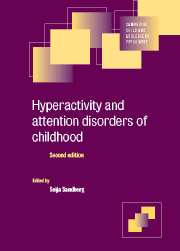Book contents
- Frontmatter
- Contents
- List of contributors
- Preface
- 1 Historical Development
- 2 Epidemiological aspects: what have we learned over the last decade?
- 3 Cross–cultural/ ethnic aspects of childhood hyperactivity
- 4 4 Sex differences and their significance
- 5 Classification issues
- 6 The role of attention
- 7 Cognitive aspects and learning
- 8 Developmental perspectives
- 9 Behavioural and molecular genetic studies
- 10 Biological underpinnings of ADHD
- 11 Psychosocial contributions
- 12 Institutional care as a risk factor for inattention/overactivity
- 13 Treatments: The case of the MTA study
- 14 Attention feficit hyperactivity disorder in adults
- Index
1 - Historical Development
Published online by Cambridge University Press: 28 August 2009
- Frontmatter
- Contents
- List of contributors
- Preface
- 1 Historical Development
- 2 Epidemiological aspects: what have we learned over the last decade?
- 3 Cross–cultural/ ethnic aspects of childhood hyperactivity
- 4 4 Sex differences and their significance
- 5 Classification issues
- 6 The role of attention
- 7 Cognitive aspects and learning
- 8 Developmental perspectives
- 9 Behavioural and molecular genetic studies
- 10 Biological underpinnings of ADHD
- 11 Psychosocial contributions
- 12 Institutional care as a risk factor for inattention/overactivity
- 13 Treatments: The case of the MTA study
- 14 Attention feficit hyperactivity disorder in adults
- Index
Summary
The constellation of overactivity, poor impulse control and inattention has been given a variety of diagnostic labels over the years. Although at present attention deficit hyperactivity disorder and hyperkinetic disorder are popular diagnoses, they are relative newcomers in the diagnostic classification of child psychiatry. For example, even the latest (1957) edition of the child psychiatry textbook by Kanner contained no reference to hyperactivity as a diagnostic entity. The same applied to the 1969 edition of a widely used text on child psychology by Johnson and Medinnus (1969), with even the term ‘attention span’ only mentioned on two of the total of 657 pages. A well-regarded textbook on experimental child psychology (Reese and Lipsitt, 1970) did include a section on attention processes, but without any reference to attention deficit hyperactivity disorder. Yet evidence of attention psychology going back at least to the latter half of the nineteenth century has been well documented (James, 1890; Spearman, 1937). On the European continent, however, the condition was recognized and referred to as ‘hyperkinetic disorder’ in Hoff's (1956) major textbook of general psychiatry. So, whilst hyperactivity tends to be thought of as a particularly American phenomenon, the history of the use of the term tells us otherwise. Though new as a diagnostic entity, hyperactive behaviour in children has been detected and treated for much longer. Indeed, the diagnosis of ‘dextro-amphetamine response disorder’ was in common use in the former German Democratic Republic (DDR: Gollnitz, 1981).
- Type
- Chapter
- Information
- Hyperactivity and Attention Disorders of Childhood , pp. 1 - 29Publisher: Cambridge University PressPrint publication year: 2002
- 5
- Cited by

